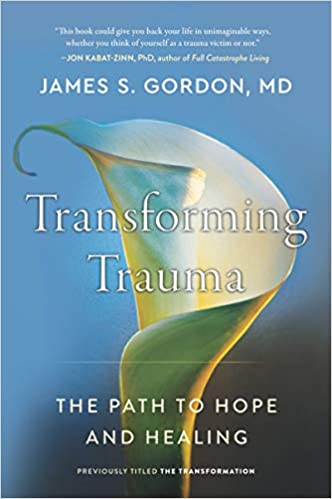All of us can move. Even those confined to wheelchairs and hospital beds have felt new energy from gentle stretching and seated or horizontal Shaking and Dancing.
And movement, especially if it’s carefully individualized to meet your needs and preferences, will give you a wide range of trauma-healing psychological and physical benefits. Even if you’re bed-hugging tired as well as traumatized, you can, like Dorothy, the cancer-challenged senator’s wife, learn to enjoy moving. After some quite eloquent protests, she began with a half-block walk to the corner, then very gradually increased her daily range.
Once she’d overcome the pull backward and bedward, Dorothy began to feel more alert and able. More energy came as she closed the front door behind her. With each satisfying fall of foot on pavement, a sense of accomplishment—and even, she had to admit, power— filled her. For a while she did ten or fifteen minutes at odd times during the day, then as she grew more fond of it, thirty to forty minutes every morning. Dorothy enjoyed the crispness of the fall air, the shadows the trees cast on her street, the sound of birds, and the children on their way to school. “You know,” Dorothy told me after several months, “it has changed me.
My body feels stronger and more energetic, and I have to admit, my mood is better. But I also feel myself. I’ve never taken time like this for myself, for my body, or met a challenge that is just my own.”
Aerobic exercise—the kind that requires oxygen and stimulates energy—increases stress-relieving, resiliency-building hormones depleted by trauma, including dopamine, serotonin, and the endorphins. Very good clinical research has shown that a variety of aerobic exercises— including jogging, swimming, and the brisk walking that Dorothy eventually did — increases brain-derived neurotropic factor. And BDNF stimulates the creation of new brain cells and improves functioning in the hippocampus, which modulates the stress produced by trauma. Clinical trials have also shown that exercise directly addresses the loss of focus and increased fatigue, anxiety, and depression that so often follow trauma. One fascinating study of female military veterans demonstrated significant improvement in PTSD symptoms after twelve weeks of fast walking for only thirty to forty minutes, four days a week.
Recent scientific studies on the postures of hatha yoga and the yogic breathing techniques of pranayama have repeatedly demonstrated improvements in symptoms of post-traumatic stress disorder. The Chinese moving meditations qi gong and tai chi appear to have similar benefits.
And exercise, as we continue to discover, can play a major role in preventing as well as treating the chronic illnesses that may follow in the wake of trauma and chronic stress, including heart disease, cancer, type 2 diabetes, arthritis, and chronic pain.
Exercise, in all its forms, also gives us a sense of increased control over bodies that trauma has agitated and made alien to us, as well as confidence and pleasure in them. For many people like Dorothy—and Sharon, who describes her daily twenty minutes of stretching as “my religion”—exercise becomes a mighty engine of trauma healing.
Exercise can also be a meditation.
Mindful walking is a pleasurable, healthy exercise that can bring more awareness and appreciation into your life. Buddhists have been practicing it for centuries. It’s simple, too. Just walk slowly—really, really slowly, at a quarter your normal pace.
Notice your thoughts, feelings, and sensations as you walk, and say them to yourself—for example, “Foot falling on the ground . . . interesting bark on the tree . . . feeling the sun on my face . . . thinking of my abusive husband . . . wondering why I’m bringing him with me to spoil the lovely day . . . breathing deeply.” When my first-year Georgetown medical students do mindful walking for twenty minutes, they are often astonished at the results. “I never knew there was a tree in that place,” says one. “I never saw that statue before,” adds another. And sometimes young men and women who’ve walked the territory a thousand times will admit, “I never knew that building was there.”
Running, jogging, or playing tennis, assuming yoga postures, and relaxing into the movements of tai chi can all be done in meditative ways. Jenna, a court clerk who had been sexually abused as a child and was overwhelmed by her work, discovered that mindful weight lifting—slow lifting accompanied by deep breathing and appreciation of every ounce of effort—relieved tension, released the rage her trauma brought, and gave her new eyes to see her life. After each session, she felt more relaxed, more comfortable in her body, less preoccupied with angry, guilty, ashamed thoughts. Ominous dead- lines became manageable. Judges and lawyers who made sexual remarks had threatened her; now they seemed pathetic. Earlier she had retreated in cold silence; now she told them off.
As we befriend our bodies, the watchwords are, once again, individuality and uniqueness. I could never have predicted that bathing or stretching would be so important to Sharon, that walking would give Dorothy such joy, or that Jenna would discover liberation through mindful weight lifting.
Studies may show that yoga is good for post-traumatic stress—and they do—but if you cringe every time you think of getting on the mat, it’s not likely to help.
Find a form of movement that suits you and . . . practice, practice, practice. Start in whatever way feels comfortable, perhaps ten, fifteen, or twenty minutes a day. Or thirty to forty minutes three or four times a week. Gradually increase the time. We humans evolved as hunter-gatherers, people who were continually bending, lifting, and carrying—and of course, walking everywhere. The genes we carry welcome the stimulation that movement brings. Interestingly and importantly, the older we get, the more we benefit from exercise.



